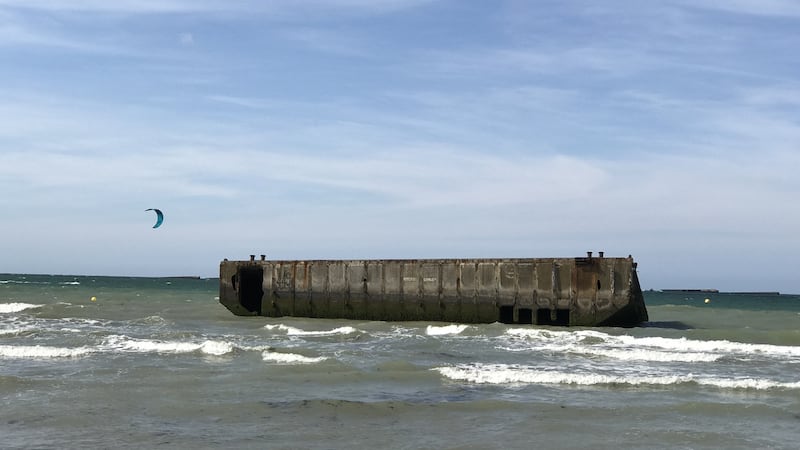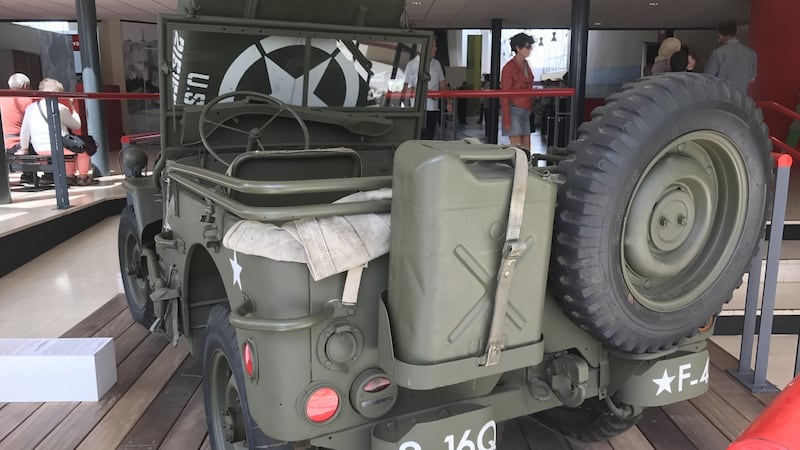I nudge the bluff nose of the Jeep up a metal ramp, and we leave the safety of terra firma and enter the nautical world that will be our home for the next 18 hours. The next time we feel land under our wheels and feet, it'll be the Normandy coast, and while I know for a fact that (a) this is a brand new Grand Cherokee and not a Willys, and (b) this is an Irish Ferries sailing and not grey-painted naval vessel, I cannot shake the image of a Landing Ship: Tank (or LST - 'Large Stationery Target' as military gallows humour would have it) from my mind.
This is for me something of a pilgrimage. I've been meaning, wanting, to go to Normandy and see the place where Private Sydney O. Walker of the Coldstream Guards Royal Signal Corps, attached to the Guard's Armoured Division, came ashore and played his part in the liberation of France, then Europe, from Nazi tyranny.
I grew up on a diet saturated with The Longest Day, The Dambusters, The Great Escape, and Where Eagles Dare. My bookshelves groan with hefty, doorstop tomes by the likes of Beevor, Harris, Holland, Ambrose, Ryan, Nicol and so many others. You think I'm nerdy about cars? Try getting me talking about Sherman Firefly versus Tiger, or the tortured gestation of the Hawker Typhoon. You'll be cramming fingers in your ears and making excuses to leave in five minutes or less…


Twenty, even ten years ago, this would have been simple. I'd have gone, I'd have paid my respects, and spent the rest of the time scampering happily over displays of military hardware and fragments of Mulberry harbour. Now though, it's a little different. I'm older now, and I fully realise how ridiculous and one-sided all those black and white movies are. I have kids of my own, and while my grandfather was British (from Sunderland, as it happens) and I'm half-Brit (the rest of me is Cork), 70 years of torturous politics and the dread hand of Brexit have muddied the waters of simple military bombast.
Legacy
I roll back down the ramp of the ferry and guide the Jeep onto French soil for the first time. It's onto the tarmac of Cherbourg, not the sands of Omaha or Sword, and the only person in uniform that I can see is asking for passports, not sighting a Spandau machine gun on me. Still, I tingle slightly with a turmoil of emotions.
You simply cannot get away from the legacy of D-Day and the battle for Normandy once you're in this part of the world. As the Grand Cherokee rolls effortlessly along the dual carriageway towards Rennes, you are surrounded by the myths, the legends, the tourist traps, and the actual, muddy, bloody legacy.
We stop at Arromanches, a charming French seaside town whose beachfront was code-named Gold and where my grandfather came ashore. On the June 7th, D-Day plus one, he gunned the engine of the truck which carried his morse radio set, and plunged into the surf.
I remember him telling me that both the air intake and the exhaust had huge snorkels on them so as to be able to drive half under water. He drove up the beach, doubtless having an easier time than did his colleagues the day before, but with German shells and mortars still falling within the 10km-deep beachhead, and with the Panzer Lehr and SS Hitler Jugend divisions massing for a counter-attack.
Modern times
We have an easier time yet, aside from struggling for a few moments to find a parking space into which to slot a car the size of the Jeep. People here tend to drive something smaller - a Peugeot 308 or a Renault Clio, or a memorable 1960s Citroen DS parked on the beachfront - but we soon find one and strike out for the beach.
Families are playing happily. A father, clad in a wetsuit, is trying to get his daughter to leave her sandcastle and come for a swim in the surf. The shops on the promenade sell a mixture of ice cream,
Calvados made from local apples, and military memorabilia both real and fake. It's a wonderfully peaceful scene, baked gently by a late-afternoon sun. Arromanches is a mixture of a place - sweets, buckets and spades on one hand, a US Army half-track parked on the promenade and the crumbling remains of the artificial Mulberry harbour still ringing the surf on the other.
My grandfather never came back here. Perhaps the memories were just too raw, to hard to which to return. He never told me a lot about his time in the war, just a few repeated stories that he felt happy telling.

The time they bivouacked in a field only to find German artillery firing over their heads from one side, and the RAF responding with rocket-firing Mosquito aircraft from the other; the time that a timely call to come to the rear and play piano at an officers’ party pulled him out of the front lines just before a major German attack.
Spielberg got it right, though. Not long before he passed away, I loaned him my VHS copy of Saving Private Ryan, and he returned it to me a couple of days later with the simple words “yup, that’s what it was like.” He retained the livid purple scars in his side, the legacy of a shrapnel wound, to his dying day.
Half an hour's drive in our Jeep from Arromanches is the city of Caen. It took us that mere thirty minutes; it took the Allied armies more than thirty days, and involved blasting the whole city flat with bombs and artillery shells. No wonder then, that the museum at Caen is a thing of wonder - factual, fascinating, filled with interest, but never tub-thumping. Thankful for the liberation, but never glorifying of the actions.
Solemnity
Normandy, it is said, was martyred to save the rest of France, and Caen more so than most. So the museum tells the story with due grace and solemnity. I catch a childish thrill at the sight of the Typhoon fighter ‘plane dangling from the ceiling, and of the Willys Jeep just to the left of its wingtip. And then I’m reminded - that Typhoon was designed to kill and destroy, nothing else. That original 1941 Jeep is tiny, un-armoured, vulnerable. Useful and dependable, true but terribly open to the elements and enemy fire.
The intentions of the Allied forces more noble, but at the end of the day it was a cauldron of mud, blood, and steel through which my grandfather, aged just 23, had to wade. As a child I’d have been thrilled silly just to stand on a Normandy beach and imagine the so-called glory and heroism of the fight. Now, standing in the same place as he did, I’m just achingly grateful that he made it home safe, and that I had to chance to spend my childhood with such a wonderful, warm, funny, man.
Peace is the prize
The Willy’s Jeep in the Caen museum has only the most tenuous connection to the big V6-diesel-engined Grand Cherokee which we drove to visit it. The name is the same, and there are the regulation seven openings in the grille, but that’s it. One is a simple, spartan, weapon of war.

The other a big, luxurious, comfortable, family SUV. Not perfect perhaps - a little aged in its cabin layout, a little ponderous in the handling - but a quiet and relaxed way to drive across and around Normandy, able to drive in an hour or two to places it took Syd months to reach, at the cost of so many friends, of so much horror.
Of course, the classic question, asked and answered by Edwin Starr is what is war good for (absolutely nothing, say it again)? And while war is the worst of human inventions, it can, in some strange way, lead to things which are better.
Perhaps it’s egregious to describe the development of the SUV and the modern 4x4 as intrinsically ‘good’ but without that original Willys, there would be no Jeep company, no Land Rover Series I copycat, no Cherokee and Grand Cherokee, no Range Rover, no Land Cruiser (another great car which started its life as an unashamed Willys knock-off).
The original Jeep, based on that US Army requirement for a compact four-wheel drive truck that could carry men and a 1/4-tonne load, was given, by General Eisenhower, the credit for the victory over fascism, along with the landing craft and the Douglas C-47 transport aircraft. It was a recognition by Eisenhower that in modern warfare, materiel strength counted for more than guts and glory.
The Jeep went on to do so much more, though. It fundamentally changed the way we buy, own, and drive cars. It took some time, but right now we are seeing the ‘traditional’ new car segments of hatchbacks, saloons, and estate falling to the might of the SUV. Everyone wants a little slice of that Jeep aura, even going so far as to erroneously refer to sundry Mitsubishis, Nissans, Land Rovers, Fords, and more as jeeps, in the generic sense.
The second World War changed the political and social landscape of Europe, the US, and Russia more than anything before or since, and Jeep’s part in that has continued far beyond VE-Day. The usefulness of such a vehicle, and the fact that surplus versions were cheap and plentiful in the years after the war, changed our perceptions of what a car can do or be.
It’s a surprise which those buyers brave enough to venture off the tarmac in a Jeep’s modern successor still find - you just shouldn’t be able to do these kinds of muddy, rock-strewn things on four wheels. But in a Jeep, you can.
My grandfather never went back to Normandy, which I can understand, but I wish he had - the best part is not the museum, nor the remains of militaria on the beach, nor the endless shops selling you camouflage jackets. The best part is the pleasant, peaceful, prosperity of it all.
The fact that Normandy, France, the rest of Europe, united under the blue flag with its gold stars, is no longer a front-line, a beach-head, a conflict zone. It’s fields, it’s roads, it’s towns and villages where the toughest task is finding a table for lunch or a parking space for a hulking American SUV. Just as it should be.


















